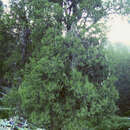Comments
provided by eFloras
An endangered species. Perhaps better treated as a variety of Cupressus torulosa, from which it differs mainly in its thicker ultimate branchlets, which are not drooping but spreading
(xeromorphy), and in that some stands in SE Xizang contain very massive trees. However, some herbarium specimens of C. torulosa collected outside China in the W Himalayan region
have similarly thick foliage, while another specimen from SE Xizang has ultimate branchlets only 0.8 mm wide.
- license
- cc-by-nc-sa-3.0
- copyright
- Missouri Botanical Garden, 4344 Shaw Boulevard, St. Louis, MO, 63110 USA
Description
provided by eFloras
Trees to 45 m tall; trunk 3(-6) m d.b.h.; branchlets densely arranged, often glaucous, stout, usually 4-angled, rarely terete, ultimate ones not drooping, 1.5-2 mm in diam. Leaves closely arranged, in 4 ranks, glaucous, scalelike, obtusely ridged or arched (gibbous) and with a rounded central abaxial gland. Seed cones usually glaucous, oblong-globose, 1.5-2 × 1.3-1.6 cm; cone scales circa 12, each fertile scale with numerous seeds; bracts with a prominent, large, free mucro at apex. 2n = 22*
- license
- cc-by-nc-sa-3.0
- copyright
- Missouri Botanical Garden, 4344 Shaw Boulevard, St. Louis, MO, 63110 USA
Distribution
provided by eFloras
SE Xizang.
- license
- cc-by-nc-sa-3.0
- copyright
- Missouri Botanical Garden, 4344 Shaw Boulevard, St. Louis, MO, 63110 USA
Habitat
provided by eFloras
* Mountain slopes, along rivers; 3000-3400 m.
- license
- cc-by-nc-sa-3.0
- copyright
- Missouri Botanical Garden, 4344 Shaw Boulevard, St. Louis, MO, 63110 USA
Diagnostic Description
provided by Plants of Tibet
Cupressus gigantea is close relative of Cupressus chengiana, but differs from the latter in its glaucous (vs. not glaucous) branchlets, bracts with a prominent, large, free mucro at apex (vs. a small, free mucro at apex).
Distribution
provided by Plants of Tibet
Cupressus gigantea is occurring in SE Xizang.
Evolution
provided by Plants of Tibet
Recent phylogenetic investigations of Cupressoideae have found evidence to suggest that Cupressus is not monophyletic. The Cupressus was divided into an Old World clade and a New World clade. Data from anatomy, biochemistry, micromorphology, reproductive development, reproductive morphology, and vegetative morphology were combined with molecular sequence data (matK, NEEDLY intron 2, nrITS, rbcL, and trnL) to produce the most complete hypothesis of evolutionary relationships within Cupressoideae. Callitropsis, Cupressus, and Juniperus formed a well-supported monophyletic group (100%). Within this clade, the only demonstrably monophyletic genus was Juniperus (100%). Monophyly of the Old World species of Cupressus was well supported (100%). Old World species of Cupressus were sister to Juniperus (99%). Callitropsis and the New World species of Cupressus were resolved as the sister group to the Old World Cupressus plus Juniperus clade (100%) (Little, 2006).
General Description
provided by Plants of Tibet
Trees to 45 m tall; trunk 3 (-6) m d.b.h.; branchlets densely arranged, often glaucous, stout, usually 4-angled, rarely terete, ultimate ones not drooping, 1.5-2 mm in diameter. Leaves closely arranged, in 4 ranks, glaucous, scalelike, obtusely ridged or arched (gibbous) and with a rounded central abaxial gland. Seed cones usually glaucous, oblong-globose, 1.5-2 cm long, 1.3-1.6 cm wide; cone scales circa 12, each fertile scale with numerous seeds; bracts with a prominent, large, free mucro at apex.
Genetics
provided by Plants of Tibet
The chromosomal number of Cupressus gigantea is 2n = 22 (Liang, 1990).
Habitat
provided by Plants of Tibet
Growing in mountain slopes, along rivers; 3000-3400 m.
Threats
provided by Plants of Tibet
Cupressus gigantea is reported be vulnerable (Conifer Specialist Group, 1998).
Cupressus gigantea
provided by wikipedia EN
Cupressus gigantea, the Tibetan cypress, is a species of conifer in the family Cupressaceae in Asia. C. gigantea was previously classified as a subspecies of Cupressus torulosa because of their similar morphological characteristics and close distribution, but have since been genetically distinguished as separate species.[2]
Distribution
It is endemic to Southeast Tibet - China on the Qinghai-Tibetan plateau, particularly in the dry valleys of Nyang River and Yarlung Tsangpo River.[3] Cupressus gigantea is the biggest of all Cupressus species.
King cypress
The biggest known specimen is the famous King Cypress, about 50 meters high, 5.8 meters in diameter, 0.165-acre (670 m2) of crown-projection-area; and calculated age of 2,600 years.
References
-
^ Zhang, D.; Qin, H.-n.; Christian, T.; Rushforth, K. (2013). "Cupressus gigantea". IUCN Red List of Threatened Species. 2013: e.T32336A2815433. doi:10.2305/IUCN.UK.2013-1.RLTS.T32336A2815433.en. Retrieved 15 November 2021.
-
^ Fu, Yaru; Li, Shaoke; Guo, Qiqiang; Zheng, Weilie; Yang, Rui; Li, Huie (2019-02-21). "Genetic diversity and population structure of two endemic Cupressus (Cupressaceae) species on the Qinghai-Tibetan plateau". Journal of Genetics. 98 (1): 14. doi:10.1007/s12041-019-1059-4. ISSN 0973-7731. PMID 30945670. S2CID 67790943.
-
^ Li, Shaoke; Qian, Zengqiang; Fu, Yaru; Zheng, Weilie; Li, Huie (2014). "Isolation and characterization of polymorphic microsatellites in the Tibetan cypress Cupressus gigantea using paired-end Illumina shotgun sequencing". Conservation Genetics Resources. 6 (3): 795–797. doi:10.1007/s12686-014-0222-8. ISSN 1877-7252. S2CID 14927898.

- license
- cc-by-sa-3.0
- copyright
- Wikipedia authors and editors
Cupressus gigantea: Brief Summary
provided by wikipedia EN
Cupressus gigantea, the Tibetan cypress, is a species of conifer in the family Cupressaceae in Asia. C. gigantea was previously classified as a subspecies of Cupressus torulosa because of their similar morphological characteristics and close distribution, but have since been genetically distinguished as separate species.
- license
- cc-by-sa-3.0
- copyright
- Wikipedia authors and editors

